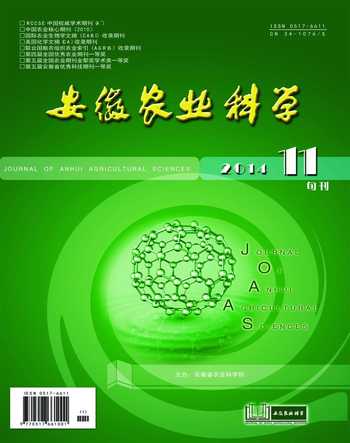响应面法优化重组毕赤酵母菌表达β甘露聚糖酶的诱导条件
李慧玲 刘祖艳 赵敏
摘要 [目的]对重组毕赤酵母菌表达β甘露聚糖酶的诱导条件进行优化。[方法]以重组毕赤酵母GS115为研究对象,通过单因素试验确定最佳产酶条件,并采用响应面试验确定3个因素的最佳水平。[结果]最佳产酶条件为:培养温度28 ℃,培养pH 6.5,摇床转速210 r/min,培养基装液量100 ml。响应面试验确定3个因素即装液量、甲醇添加量和pH最佳值分别为103.18 ml、1.77%和6.69;在此条件下,β甘露聚糖酶的活力最大值为4 917.5 U/ml。[结论]验证试验证明模型预测值准确、可靠,为重组毕赤酵母菌的合理开发利用提供了依据。
关键词 重组毕赤酵母;β甘露聚糖酶;响应面
中图分类号 S182 文献标识码 A 文章编号 0517-6611(2014)11-03153-03
Abstract [Objective] To optimize the induction conditions of the recombinant Pichia pastoris βmannanase. [Method] With recombinant Pichia pastoris GS115 as study object, the optimal enzyme producing conditions and three factors optimal level were determined by single factor experiment and response surface experiment respectively. [Result] The optimum enzyme producing conditions are: temperature 28 ℃, pH 6.5, rotating speed 210 r/min, volume of medium 100 ml. Response surface methodology was used to optimize the above three factors(volume of medium, methanol concentration, pH of medium)with the optimum value 103.18 ml, 1.77%, 6.69, respectively. The βmannanase activity would reach the highest value(4 917.5 U/ml) under the optimized fermentation conditions. [Conclusion] The predicted values from the response surface methodology were proved to be correct and reliable by verification test, which will provide a reference for appropriate utilization and development of recombinant Pichia pastoris.
Key words Recombinant Pichia pastoris; βmannanase; Response surface methodology
β1,4D甘露聚糖酶(β1,4Dmannan mannanohydrolase,EC 3.2.l.78),简称为β甘露聚糖酶(βmannanase)属于半纤维素酶类,可以断裂β1,4D甘露糖苷键[12]。β甘露聚糖酶广泛应用于纸浆、饲料和钻井等生产领域[3-6]。
β甘露聚糖酶存在于细菌、酵母菌、丝状真菌和植物中[6]。来自于细菌的β甘露聚糖酶已被分离得到,如Bacillus subtilis WY34、Cellulosimicrobium sp.strain HY13、Sphingomonas strain等[7-9]。克隆细菌的β甘露聚糖酶并且高效异源表达有助于满足工业生产的需求。甲醇营养型毕赤酵母成功作为高水平表达异源蛋白的表达系统[10-11]。
笔者为了使构建的重组毕赤酵母表达β甘露聚糖酶潜力充分发挥出来,优化其发酵过程,以获得较高的产物浓度。研究选用装液量、甲醇添加量和pH值3个关键因素为自变量,以重组β甘露聚糖酶的酶活力为响应值,利用响应面法(response surface methodology,RSM)进行发酵条件优化并确定最佳方案,以期为重组毕赤酵母的进一步开发利用提供依据。
1 材料与方法
1.1 材料
1.1.1 供试菌株。分泌表达β甘露聚糖酶的重组毕赤酵母菌Man12,由东北林业大学微生物与免疫实验室保存。
1.1.2 主要试剂。培养基的配制方法参见Invitrogen公司《毕赤酵母操作手册》。
1.2 方法
1.2.1 菌株的诱导表达。取-80 ℃冰箱保存的甘油菌接种于YPD培养基中,划线活化,28 ℃倒置培养。挑取菌株接种至BMGY培养基中培养16~18 h至OD600=2~6,离心收集菌体,用BMMY重悬菌体,使OD600=1.0左右;取菌液继续震荡培养,每隔24 h加入无水甲醇诱导,诱导72 h,测定酶活性。
1.2.2 粗酶液的制备。取诱导表达Man12菌株培养液,离心后上清液即为粗酶液。
1.2.3 重组β甘露聚糖酶活力测定方法。采用改进的3,5-二硝基水杨酸法(DNS方法)测定酶活力[12],利用比色法测定酶解后还原产物的生成量,以表示酶的活力。酶活力定义:在一定温度和pH下,以每分钟生成相当于1 μmol D甘露糖所需酶量为一个酶活力单位(IU)。
1.2.4 培养温度对重组毕赤酵母产酶的影响。重组毕赤酵母菌分别在24、26、28、30和32 ℃条件下培养,以确定最佳培养温度。
1.2.5 甲醇浓度对重组毕赤酵母产酶的影响。在BMGY培养基中分别添加浓度为0.25%、0.50%、1.00%、1.50%、2.00%和2.50%的甲醇,诱导培养72 h后测定酶的活力,以确定甲醇的最佳添加量。
1.2.6 不同pH值对重组毕赤酵母产酶的影响。通过添加0.1 mol/L的磷酸钾缓冲液使培养基的pH值分别达到3.0、4.0、5.0、6.0、7.0和8.0的培养基,经甲醇诱导表达72 h后测定酶的活力,以获得发酵培养最佳pH值。
1.2.7 摇床转速对重组毕赤酵母产酶的影响。重组毕赤酵母菌摇床培养时转速分别设定为180、190、200、210、220和230 r/min,进行培养。
1.2.8 培养基装液量对重组毕赤酵母产酶的影响。分别将50、70、100、110、120和130 ml经BMMY重悬的菌液装入500 ml三角瓶中培养,测定酶活,获得最佳装液量。
1.2.9 响应面优化发酵条件。利用DesignExpert软件进行装液量、甲醇添加量和培养基pH3个条件的响应面分析,以β-甘露聚糖酶酶活力为响应值。
随着装液量和pH的增加,酶活变化是先升高后降低。方差分析表明,装液量和pH交互作用不显著(P>0.05)。图7表明,甲醇加入量是1.5%时,随着装液量的增加,酶活逐渐降低,因为摇瓶培养时,液体过多,酵母菌通气不畅,影响其正常生长,所以酶活下降。当甲醇加入量是达2.1%以上时,随着装液量的增加,酶活变化不大,推测原因是甲醇诱导外源基因大量表达,所以产酶较多。方差分析表明,甲醇加入量和装液量交互作用极显著(P<0.01)。图8表明,当甲醇添加量为1.5%时,随着pH值的增加,酶活先升高后降低;当甲醇添加量是2.3%时,趋势相同。毕赤酵母是成功的表达系统,已得到广泛应用。不同毕赤酵母产外源
蛋白的培养条件有一定差别,需要后期优化其发酵条件,以获得更多的表达产物。
3 结论
试验利用响应面分析方法优化重组酵母菌摇瓶培养条件,最终获得产酶最优条件为:培养温度为28 ℃,摇床转速是210 r/min,装液量是103.18 ml(500 ml三角瓶)、甲醇加入量为1.77%、pH是6.69,为重组毕赤酵母的中试发酵生产奠定基础。
参考文献
[1]
MCCLEARY B V.βmannanase[J].Methods in Enzymology,1988,160:596-610.
[2] SCHOMBUG D,SALZMANN M.Enzyme Handbook[M].Berlin:SpringerVerlay Berlin Heideberg,1991,1-5.
[3] BENECH R O,LI X,PATTON D,et al.Recombinant expression,characterization,and pulp pr ebleaching property of a Phanerochaete chrysosporium endoβ1,4mannanase[J].Enzyme and Microbial Technology,2007,41:740-747.
[4] WU G,BRYANT M M,VOITLE R A,et al.Effects of βmannanase in cornsoy diets on commercial leghorns in secondcycle hens[J].Poultry Science,2005,84:894-897.
[5] DHAWAN S,KAUR J.Microbial mannanases:an overview of production and applications[J].Crit Rev Biotechnol,2007,27:197-216.
[6] MOREIRA L R S,FILHO E X F.An overview of mannan structure and mannandegrading enzyme systems[J].Appl Microbiol Biotechnol,2008,79:165-178.
[7] JIANG Z Q,WEI Y,LI D Y,et al.Highlevel production,purification and characterization of a thermostable βmannanase from the newly isolated Bacillus subtilis WY34[J].Carbohydrate Polymers,2006,66:88-96.
[8] KIM D Y,HAM S J,LEE H J,et al.Cloning and characterization of a modular GH5 β1,4mannanase with high specific activity from the fibrolytic bacterium Cellulosimicrobium sp.strain HY13[J].Bioresource Technology,2011,19:9185-9192.
[9] ZHOU J P,ZHANG R,GAO Y J,et al.Novel lowtemperatureactive,salttolerant and proteasesresistant endo1,4βmannanase from a new Sphingomonas strain[J].Journal of Bioscience and Bioengineering,2012,5:568-574.
[10] DALY R,HEARN M T.Expression of heterologous proteins in Pichia pastoris: a useful experimental tool in protein engineering and production[J].J Mol Recognit,2005,18:119-138.
[11] MACAULEYPATRICK S,FAZENDA M L,MCNEIL B,et al.Heterologous protein production using the Pichia pastoris expression system[J].Yeast,2005,22:249-270.
[12] MILLER G L.Use of dinitrosalicylic acid reagent for determination of reducing sugar[J].Anal Chem,1959,31:426-428.
[13] 韩雪清,刘湘涛,尹双辉.毕赤酵母表达系统[J].微生物学杂志,2003,23(4):35-40.

